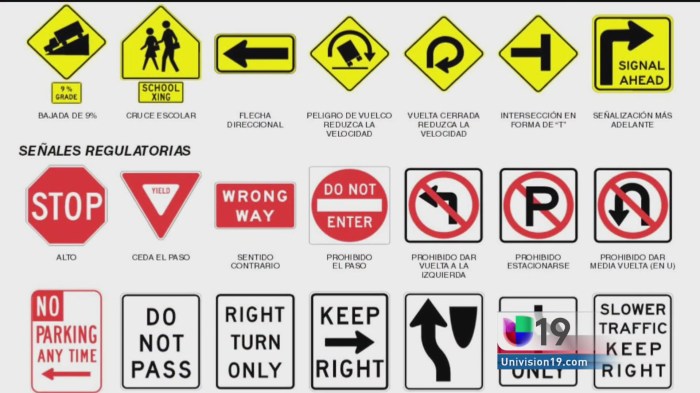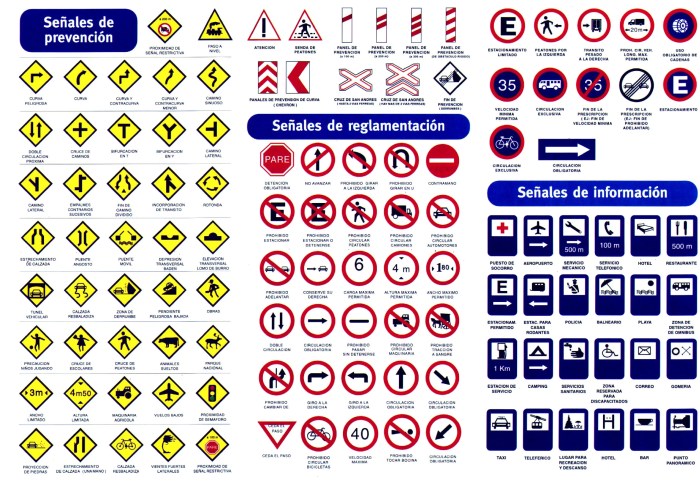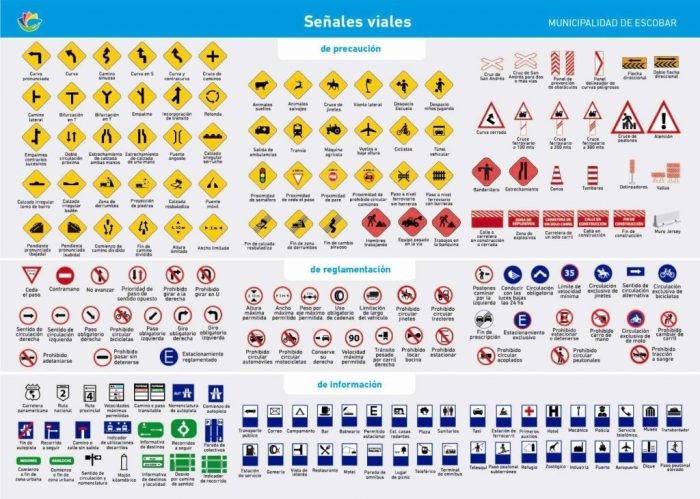Examen de señales de transito – Welcome to the world of road sign examination, where understanding and interpreting traffic signs are crucial for safe and efficient driving. In this comprehensive guide, we’ll delve into the significance of road signs, their various categories, and the cognitive processes involved in recognizing and interpreting them.
Get ready to enhance your driving skills and navigate the roads with confidence.
Road signs serve as visual cues that provide essential information to drivers, helping them make informed decisions and avoid potential hazards. They come in various shapes, colors, and symbols, each conveying a specific message. Understanding these signs is not just about memorizing their meanings but also about developing the ability to quickly recognize and interpret them in real-time driving situations.
Road Signs and Their Importance
Road signs are visual aids used to communicate important information to drivers and pedestrians, enhancing traffic safety and maintaining order on the roads. They provide clear instructions, warnings, and guidance to ensure smooth and efficient movement of vehicles and people.
Categories of Road Signs
Road signs are broadly classified into three main categories:
- Regulatory Signs:These signs impose specific rules and regulations that drivers must obey. They include stop signs, yield signs, speed limit signs, and no-parking signs.
- Warning Signs:These signs alert drivers to potential hazards or dangers ahead, such as curves, intersections, or slippery roads. They are typically yellow and diamond-shaped with black symbols.
- Informational Signs:These signs provide information about directions, distances, services, and other useful details. They are usually blue or green with white lettering.
Types of Road Signs

Road signs play a crucial role in ensuring safety and smooth flow of traffic. They convey important information to drivers, pedestrians, and cyclists, helping them make informed decisions while navigating the roads.
Road signs are classified into different types based on their shape, color, symbol, and meaning. Here’s a comprehensive table categorizing the various types of road signs:
| Sign Shape | Color | Symbol | Meaning |
|---|---|---|---|
| Round | Red | Stop sign | Requires drivers to come to a complete stop |
| Octagonal | Yellow | Yield sign | Requires drivers to yield to oncoming traffic |
| Rectangular | Blue | Speed limit sign | Indicates the maximum allowable speed |
| Square | Green | Informational sign | Provides general information, such as directions or distances |
Understanding the different types of road signs is essential for safe and responsible driving. By recognizing and obeying these signs, drivers can contribute to a safer and more efficient traffic environment.
Understanding Road Signs
Understanding road signs is crucial for safe driving. They provide vital information and instructions to drivers, helping them navigate the road safely and efficiently. Comprehending road signs requires a combination of cognitive processes, including perception, recognition, and interpretation.
Cognitive Processes Involved
When encountering a road sign, drivers first perceive the visual cues, such as its shape, color, and symbols. They then recognize the sign based on their prior knowledge and experience. Finally, they interpret the meaning of the sign and make appropriate decisions.
Tips for Effective Reading
- Pay attention to the shape and color:Different shapes and colors convey specific types of information. For example, red octagonal signs indicate stop signs, while yellow diamond signs warn of potential hazards.
- Scan for symbols:Road signs often use symbols to convey information. Familiarize yourself with common symbols to quickly identify their meaning.
- Read the text carefully:Many signs include text that provides additional details. Take the time to read and understand the full message.
- Anticipate upcoming signs:Road signs are often placed in advance to provide ample time for drivers to react. Pay attention to signs that indicate upcoming changes in the road.
Conclusion
Understanding road signs is essential for safe and responsible driving. By recognizing, interpreting, and responding appropriately to road signs, drivers can navigate the road confidently and reduce the risk of accidents.
Road Sign Recognition Tests

Road sign recognition tests are designed to assess your ability to identify and understand the different types of road signs. These tests are typically required as part of the driver’s license application process and can help ensure that you are a safe and responsible driver.
There are several different types of road sign recognition tests available, including written tests, oral tests, and practical tests. Written tests typically consist of multiple-choice questions that test your knowledge of the different types of road signs and their meanings.
Oral tests may involve being asked to identify and explain the meaning of road signs from a series of images. Practical tests involve driving a vehicle and being able to identify and respond to road signs in real-time.
Preparing for a Road Sign Recognition Test
To prepare for a road sign recognition test, it is important to study the different types of road signs and their meanings. You can find this information in the driver’s manual for your state or country. It is also helpful to practice identifying road signs while driving with a licensed driver.
Taking a Road Sign Recognition Test
When taking a road sign recognition test, it is important to remain calm and focused. Read the instructions carefully and make sure you understand what is being asked of you. If you are unsure about the meaning of a road sign, ask the examiner for clarification.
Road Sign Design and Standards

Road sign design plays a vital role in ensuring road safety and effective communication with drivers. Specific principles and standards guide the creation of road signs to enhance their visibility, clarity, and comprehension.
Factors Influencing Road Sign Design, Examen de señales de transito
Several factors influence the effectiveness of road sign design, including:
-
-*Visibility
Signs should be designed to be easily seen from a distance, both day and night. Factors like size, shape, color, and contrast contribute to visibility.
-*Clarity
The message conveyed by the sign should be clear and unambiguous. The use of symbols, pictograms, and concise text enhances clarity.
-*Comprehension
The sign’s message should be easily understood by drivers from diverse backgrounds and languages. International standards and symbols help promote comprehension.
-*Consistency
Road signs should follow consistent design principles to maintain uniformity and avoid confusion. This includes using standard colors, shapes, and symbols for specific types of signs.
Examples of Well-Designed Road Signs
Well-designed road signs effectively communicate their message and enhance road safety. Some examples include:
-
-*Stop Sign
The iconic red octagonal sign with white lettering commands drivers to come to a complete stop. Its distinctive shape and color make it highly visible and recognizable.
-*Speed Limit Sign
The circular sign with a black number on a white background clearly indicates the maximum allowable speed. Its simplicity and clarity ensure easy comprehension.
-*Pedestrian Crossing Sign
The rectangular sign with a silhouette of a person walking conveys the presence of a pedestrian crossing. Its yellow background and black symbol enhance visibility and alert drivers to exercise caution.
Road Sign Placement and Visibility
The proper placement of road signs is crucial for ensuring their visibility and comprehension by road users. Well-placed signs provide timely information, allowing drivers to make informed decisions and navigate safely. Conversely, poorly placed signs can be easily missed or misinterpreted, leading to confusion and potential hazards.
Factors Affecting Road Sign Visibility
- Sign Size:Larger signs are more visible from a distance, especially at night or in poor weather conditions.
- Location:Signs should be placed at an appropriate height and angle to ensure they are visible to drivers. They should not be obstructed by vegetation, buildings, or other structures.
- Lighting:Illuminated signs are essential for nighttime visibility. Signs with reflective materials can also enhance visibility in low-light conditions.
Guidelines for Effective Road Sign Placement
- Adequate Visibility:Signs should be placed where they can be clearly seen by drivers approaching from all directions.
- Unobstructed View:Signs should not be blocked by trees, buildings, or other obstacles.
- Appropriate Height:Signs should be placed at a height that is easily visible to drivers, typically around eye level.
- Clear and Concise:Signs should convey their message clearly and concisely, using simple and recognizable symbols or text.
- Consistent Placement:Similar signs should be placed in consistent locations across different roads and regions.
Road Sign Maintenance and Updating

Road signs play a crucial role in ensuring road safety and smooth traffic flow. Regular maintenance and updating of these signs are essential to ensure their effectiveness and reliability.
Various factors can damage or deteriorate road signs, including weather conditions, vandalism, accidents, and natural disasters. Faded, damaged, or missing signs can lead to confusion, errors, and potential accidents.
Passing the examen de señales de transito is crucial for navigating the roads safely. To enhance your knowledge, explore words with the root word nov , which often denote new or recent concepts. Understanding these terms will help you grasp the nuances of traffic regulations and ensure a smooth and safe driving experience.
Guidelines for Road Sign Maintenance and Updating
To maintain and update road signs effectively, several guidelines should be followed:
- Regular Inspections:Road signs should be inspected regularly to identify any damage, fading, or other issues that may affect their visibility and effectiveness.
- Prompt Repairs and Replacements:Damaged or missing signs should be repaired or replaced promptly to ensure continuous and clear communication to road users.
- Use of Durable Materials:Road signs should be made of durable materials that can withstand harsh weather conditions and resist fading or damage.
- Proper Placement and Visibility:Signs should be placed in conspicuous locations with clear visibility to road users. They should be free from obstructions and positioned at appropriate heights.
- Retroreflectivity and Illumination:Signs should be retroreflective or illuminated to ensure visibility at night or in low-light conditions.
- Compliance with Standards:Road signs should adhere to established standards and regulations regarding size, shape, color, and symbolism to ensure consistency and clarity.
By following these guidelines, road authorities can ensure that road signs remain effective in conveying important information to road users, contributing to road safety and efficient traffic management.
Road Sign Innovations and Advancements: Examen De Señales De Transito
The realm of road signs is undergoing a technological transformation, driven by the convergence of emerging technologies. These advancements aim to enhance traffic safety, streamline traffic flow, and improve the overall driving experience.
Smart Road Signs
- Utilize sensors, cameras, and wireless communication to gather real-time traffic data and display dynamic messages. This allows for timely adjustments to speed limits, lane closures, and other traffic conditions, optimizing traffic flow and reducing congestion.
- Can detect and communicate with connected vehicles, providing drivers with personalized guidance and alerts based on their specific needs and route.
Augmented Reality Road Signs
- Project virtual road signs onto the road surface, visible only through AR-enabled devices. These signs can provide additional information, such as navigation cues, hazard warnings, and real-time traffic updates, enhancing situational awareness and improving safety.
- Can be dynamically adjusted based on weather conditions, traffic volume, and other factors, ensuring that drivers receive the most relevant and up-to-date information.
Holographic Road Signs
- Project 3D holographic images of road signs that are visible from multiple angles, improving visibility and reducing the risk of accidents caused by obscured or missed signs.
- Can display complex and detailed information, such as intersection layouts, detours, and upcoming hazards, enhancing driver comprehension and decision-making.
Question & Answer Hub
What are the different categories of road signs?
Road signs are typically categorized into three main types: regulatory signs (e.g., stop signs, speed limit signs), warning signs (e.g., curves ahead, pedestrian crossing), and informational signs (e.g., route markers, distance markers).
Why is it important to understand road signs?
Understanding road signs is crucial for safe driving as they provide essential information about traffic regulations, potential hazards, and directions. By recognizing and interpreting these signs, drivers can make informed decisions and avoid accidents.
What are some tips for effectively reading and comprehending road signs?
To effectively read and comprehend road signs, focus on identifying the shape, color, and symbol of the sign. Pay attention to the text or numbers on the sign and relate them to your current driving situation. Anticipate upcoming signs by scanning the road ahead.